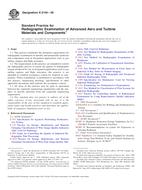Potřebujeme váš souhlas k využití jednotlivých dat, aby se vám mimo jiné mohly ukazovat informace týkající se vašich zájmů. Souhlas udělíte kliknutím na tlačítko „OK“.
ASTM D7685-11
Standard Practice for In-Line, Full Flow, Inductive Sensor for Ferromagnetic and Non-ferromagnetic Wear Debris Determination and Diagnostics for Aero-Derivative and Aircraft Gas Turbine Engine Bearings
Automaticky přeložený název:
Standardní praktiky pro in-line, plného toku, indukční snímač pro feromagnetických a Non-feromagnetického otěr stanovení a diagnostiky pro Aero-derivátu a Aircraft plynu Ložiska turbínového motoru
NORMA vydána dne 1.1.2011
Informace o normě:
Označení normy: ASTM D7685-11
Poznámka: NEPLATNÁ
Datum vydání normy: 1.1.2011
Kód zboží: NS-38956
Počet stran: 14
Přibližná hmotnost: 42 g (0.09 liber)
Země: Americká technická norma
Kategorie: Technické normy ASTM
Kategorie - podobné normy:
Motory a hnací systémy letadel a kosmických dopravních prostředků
Anotace textu normy ASTM D7685-11 :
Keywords:
alarm limits, bearing failure, ferromagnetic debris, non-ferromagnetic debris, gas turbines, in-line, metallic wear debris, sensors, wear particles, ICS Number Code 49.050 (Aerospace engines and propulsion systems)
Doplňující informace
| Significance and Use |
|
This practice is intended for the application of in-line, full-flow inductive wear debris sensors. According to (1), passing the entire lubrication oil flow for aircraft and aero-derivative gas turbines through a debris-monitoring device is a preferred approach to ensure sufficient detection efficiency. Periodic sampling and analysis of lubricants have long been used as a means to determine overall machinery health (2). The implementation of smaller oil filter pore sizes for machinery operating at higher rotational speeds and energies has reduced the effectiveness of sampled oil analysis for determining abnormal wear prior to severe damage. In addition, sampled oil analysis for equipment that is remote or otherwise difficult to monitor or access is not practical. For these machinery systems, in-line wear debris sensors can be very useful to provide real-time and near-real-time condition monitoring data. In-line full-flow inductive debris sensors have demonstrated the capability to detect and quantify both ferromagnetic and non-ferromagnetic metallic wear debris. These sensors record metallic wear debris according to size, count, and type (ferromagnetic or non-ferromagnetic). Sensors are available for a variety of oil pipe sizes. The sensors are designed specifically for the protection of rolling element bearings and gears in critical machine applications. Bearings are key elements in machines since their failure often leads to significant secondary damage that can adversely affect safety, operational availability, or operational/maintenance costs, or a combination thereof. The main advantage of the sensor is the ability to detect early bearing damage and to quantify the severity of damage and rate of progression of failure towards some predefined bearing surface fatigue damage limiting wear scar. Sensor capabilities are summarized as follows: In-line full flow non-intrusive inductive metal detector with no moving parts. Detects both ferromagnetic and non-ferromagnetic metallic wear debris. Detects 95% or more of metallic wear debris above some minimum particle size threshold. Counts and sizes wear debris detected. Fig. 1 presents a widely used diagram (2) to describe the progress of metallic wear debris release from normal to catastrophic failure. It must be pointed out that this figure summarizes metallic wear debris observations from all the different wear modes that can range from polishing, rubbing, abrasion, adhesion, grinding, scoring, pitting, spalling, etc. As mentioned in numerous references (1-11), the predominant failure mode of rolling element bearings is spalling or macro pitting. When a bearing spalls, the contact stresses increase and cause more fatigue cracks to form within the bearing subsurface material. The propagation of existing subsurface cracks and creation of new subsurface cracks causes ongoing deterioration of the material that causes it to become a roughened contact surface as illustrated in Fig. 2. This deterioration process produces large numbers of metallic wear debris with a typical size range from 100 to 1000 microns or greater. Thus, rotating machines, such as gas turbines and transmissions, which contain rolling element bearings and gears made from hard steel tend to produce this kind of large metallic wear debris that eventually leads to failure of the machines. In-line wear debris monitoring provides a more reliable and timely indication of bearing distress for a number of reasons: |
| 1. Scope |
|
1.1 This practice covers the minimum requirements for an in-line, non-intrusive, through-flow oil debris monitoring system that monitors ferromagnetic and non-ferromagnetic metallic wear debris from both industrial aero-derivative and aircraft gas turbine engine bearings. Gas turbine engines are rotating machines fitted with high-speed ball and roller bearings that can be the cause of failure modes with high secondary damage potential. (1) 1.2 Metallic wear debris considered in this practice range in size from 120 μm (micron) and greater. Metallic wear debris over 1000 μm are sized as over 1000 μm. 1.3 This practice is suitable for use with the following lubricants: polyol esters, phosphate esters, petroleum industrial gear oils and petroleum crankcase oils. 1.4 This practice is for metallic wear debris detection, not cleanliness. 1.5 The values stated in SI units are to be regarded as standard. The values given in parentheses are provided for information only. 1.6 This standard does not purport to address all of the safety concerns, if any, associated with its use. It is the responsibility of the user of this standard to establish appropriate safety and health practices and determine the applicability of regulatory limitations prior to use. |
Podobné normy:
Historická
1.1.2009
Historická
1.9.2013
Historická
1.12.2010
Historická
1.3.2011
Historická
1.6.2014



 ASTM E2104-09
ASTM E2104-09 ASTM F2506-13
ASTM F2506-13 ASTM F2538-07a(2010)..
ASTM F2538-07a(2010).. ASTM F2840-11
ASTM F2840-11 ASTM F3005-14a
ASTM F3005-14a
 Cookies
Cookies
